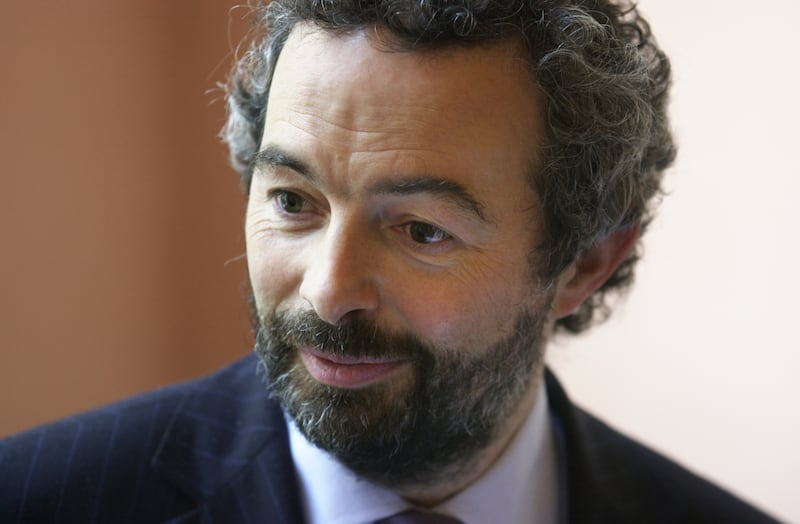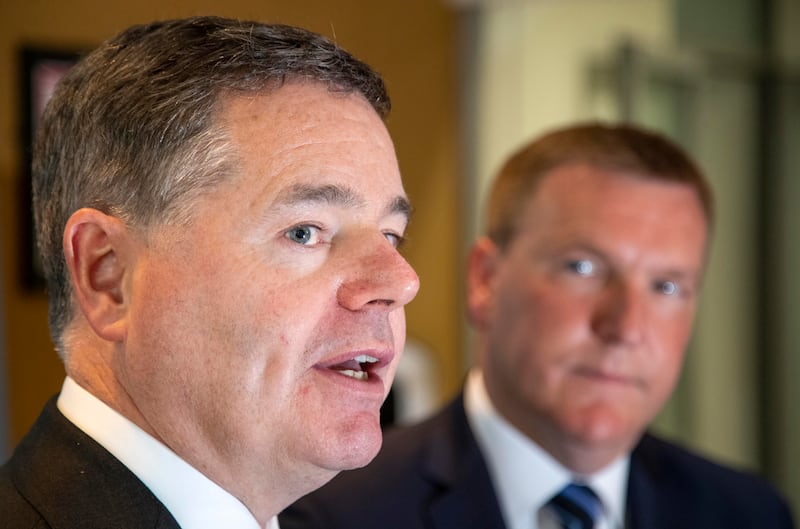It all started so well. By early this year, it was clear that the economy had survived Covid-19 in better shape than anticipated and it was already into a rebound from the pandemic shutdowns, even though the final restrictions were not lifted until the end of February. Growth had been much stronger than expected in 2021 as restrictions were slowly lifted, as the multinational sector had thrived through the pandemic. A rise in the inflation rate to 5 per cent in January was seen as a temporary inconvenience, a short-term problem caused by Covid reopenings.
And then, on February 24th – just four days before the lifting of the final Covid restrictions – Russia invaded Ukraine. Ireland, and the rest of Europe, was heading straight out of one crisis and into another. As energy prices started to soar, one of the key channels through which this would affect us all became clear – a surge in inflation unprecedented in modern times, spreading from energy and food across much of the economy. The resulting jump in interest rates has turned the financial world upside down.
So we have entered another deeply odd economic year. Household finances have been hit hard, leading to the first fall in real living standards since after the 2008 financial crash. Consumer spending, which surged in the second half of 2021, is now under pressure and is falling in real terms – in other words, people are having to divert more spending to essentials such as energy and food and are getting less overall for their money.
But Ireland still has a lot riding on a few really big firms in the tech, pharma and medtech sectors.
“The economy was thriving for most of 2022 on almost every metric, but it was difficult to enjoy when from early in the year we were haunted by the Ghost of Christmas Future,” says Gerard Brady, chief economist at employers’ body Ibec.
“Any analyst would say it was a good year if the economy added 80,000 mostly high-paid jobs, saw the income tax take rise by 16 per cent, have bank deposits per household nearing €70,000 and a domestic economy which recovered almost immediately back to activity well north of its pre-pandemic levels,” he says.
Sense of unease
So why the sense of unease and the impact of the cost-of-living crisis? Is it just a question of timing, with the economic data likely to turn more uniformly negative next year as the cost-of-living crisis takes hold? US economist and former treasury secretary Larry Summers recently compared the US consumer to the cartoon character Wile E Coyote who would disappear over a cliff edge with his legs still running, remaining suspended for a few seconds before plummeting to earth. In other words, he believes there is trouble ahead.
What about Ireland? “The spectre of quickly rising energy costs and interest rates has damaged sentiment throughout 2022,″ says Brady. “We are now entering a more difficult phase where households are starting to feel a real shock to their incomes.”
[ A big gap is appearing in the funding of new home constructionOpens in new window ]
We have been seeing this in the forward and sentiment indicators for some time – such as purchasing managers indices which look at expectations in manufacturing and service sectors – even though real activity has, up to now, remained strong. And in consumer sentiment indicators.
“Recent PMI surveys indicate the Irish economy is slowing, if not already contracting in some sectors, but is still holding up better than in Europe or the UK,” according to Conall MacCoille, chief economist at Davy Stockbrokers. He reckons that the budget surplus this year will exceed €5 billion, giving the Government scope to take further measures to protect those on low incomes next year, for example by extending some of the temporary supports recently introduced.
For the few years before the pandemic, Ireland enjoyed a period of extraordinary growth, driven by a range of factors, all of which were helping at once. All the winds were behind us. These included rock-bottom interest rates, an extraordinary period of growth for the tech and pharma sectors which provided jobs and – via international restructuring – also gave a huge boost to tax revenues. In hindsight it is clear that this momentum pushed the economy through Covid-19, maintaining employment in much of the economy and creating resources to allow the Government to support the worst-hit areas of domestic business. The economy exited the Covid-19 lockdowns with an extraordinary labour shortage, the last thing anyone expected when the pandemic hit.
Gradually during 2022 things changed, driven in large part by the cost-of-living crisis. It looks likely to be a year of transition for the economy; no longer do we have all the winds in our favour. Now things are more mixed and the international geopolitical environment remains unsettled. The tech sector is under pressure, with then tánaiste Leo Varadkar saying that thousands rather than hundreds of jobs are likely to be lost. Tech will bounce again, but there may be some pain before this happens. In the meantime, the pharma and medtech sectors remain strong.
[ Cliff Taylor: There is no doubt that the Irish economy is at a turning pointOpens in new window ]
In the domestic economy, meanwhile, consumer incomes are under pressure from the cost-of-living crisis, putting pressure on spending and domestic businesses, many just shaking themselves down after Covid. Government supports have limited the immediate damage on lower-income people in particular. But huge savings remain in bank accounts and can support spending, at least from better-off households which are generally the ones holding these valuable cash piles. An unpredictable factor heading into 2023, nonetheless, will be confidence as high prices become entrenched. Even if the rate of inflation falls, the actual level of prices will remain high.
‘Surging and slipping’
There has often been talk of the two-tier Irish economy, but it has rarely been clearer than in 2022. Looking at the third-quarter figures for growth, economist Austin Hughes says there are signs of both “surging and slipping”, with the multinational sectors strong, but the domestic economy suffering under the pressures of the cost-of-living crisis. Despite the problems of the tech sector, the data showed the key growth sectors that have driven the economy in recent years remain strong, while the domestic economy of consumers and smaller businesses are suffering.
Remarkably, Irish gross domestic product (GDP) growth could again be in double figures this year and, while the domestic economy will also be a lot stronger on average than in 2021, due partly to the Covid bouncebacks, domestic demand slipped between the second and third quarters and will likely fall again in the final months.

The consumer economy has been in and out and out of “recessions”, first because of Covid and now due to the cost-of-living crisis GDP – as defined by two successive quarters of falling activity. Hughes calculates that higher prices have cost Irish households a chunky €3,000 this year and could cost another €2,000 next year. But still, the overall economic figures are strong, illustrating, says Hughes, the radically different forces affecting the different parts of the economy.
The coincidence of these two factors goes a long way towards explaining the resilience of the overall economy in adverse circumstances. Central to this has been a huge investment programme by the multinational sector in the last six or seven years. Unpicking this is difficult, but it is clear that, as well as investments related to tax planning, driven by new international rules introduced in 2015, there has been massive real investment, creating jobs and spin-off activity. In the last year alone, employment in companies assisted by the IDA rose by 9 per cent to a record level of over 301,000. However, the agency has warned that from the middle of 2023 inward investment could start to slow.
According to Hughes, “the Irish economy is experiencing a profound, possibly temporary, but very positive shock from notably increased multinational activity”. This is translating to increased employment and wages, as well as output, with the wage bill of the multinational sector increasing 16.4 per cent over the past year, compared to 3.2 per cent in domestically owned enterprises. This is one reason why the problems in the tech sector – and notably in digital services – bear such close watching over the coming months.
In addition to the employment surge, the multinational economy has also provided a huge boost to the exchequer finances. Figures for the year to the end of November showed an extraordinary exchequer surplus of €12.1 billion, with corporation tax and income tax both surging. There was surprising growth in VAT receipts too, despite the problems of consumers.

The rise in corporation tax, set to reach at least €23 billion this year – from just €5 billion in 2015 – has been much discussed, along with the exposure it creates if anything goes wrong, Corporation tax now accounts for about one-quarter of all tax revenue, a high figure by historical or international standards. And the exposure is greater, given that many of the better-paid employees paying high levels of income tax are employed in this sector. Ireland has a lot riding on a few really big firms in the tech, pharma and medtech sectors.
Awash with cash
The two budget Ministers, Paschal Donohoe and Michael McGrath, managed to persuade their Cabinet colleagues to put €2 billion aside in a new National Reserve Fund this year, with another €4 billion to be paid in next year. Other money has been salted away in contingency funds and an expected budget surplus will give further room for manoeuvre next year. The State’s cash position is also extraordinarily strong, with €27 billion in cash reserves and the National Treasury Management Agency planning to raise just €7 billion next year, having raised extra funds when interest rates were low.
The exchequer is awash with cash. And political pressure will come to spend more to address the key problem areas – health and housing. The Government has been successful in piloting the economy over the past couple of years, but progress in these two areas remains slow despite a huge ramp-up in spending. House completion looks set to rise to 28,000 this year – after the unfortunate fall-off during Covid.

This is an improvement, though still below the 33,000 target in the Government’s Housing for All Strategy. But more worrying are signs in the housing starts and planning permission statistics that new starts are slowing under the pressure of higher interest rates. And, as in health, it appears that the sharper-than-expected rise in the population as shown by the results of the 2022 census is increasing pressure. Housing experts believe the 33,000 target for new homes each year is likely to have to be pushed up to 40,000 or more. In this context, battling the signalled slowdown in housing starts is one of the key political challenges heading into 2023.
The resources are there to tackle these key issues – but achieving progress remains challenging. The influx of foreign investment has added to the pressure on housing, infrastructure and energy, but also created massive new resources. On the other side of the ledger, there are massive new spending pressures from the green transition, the ageing population and spending on health and housing.
[ Cliff Taylor: Despite the economic slowdown, the exchequer is now awash with cashOpens in new window ]
It remains to be seen if the huge strength in the multinational sector can continue – the tech sector looks shaky in the short term but other sectors look strong. For now, with the domestic economy under pressure, the tale of two economies looks set to continue.











